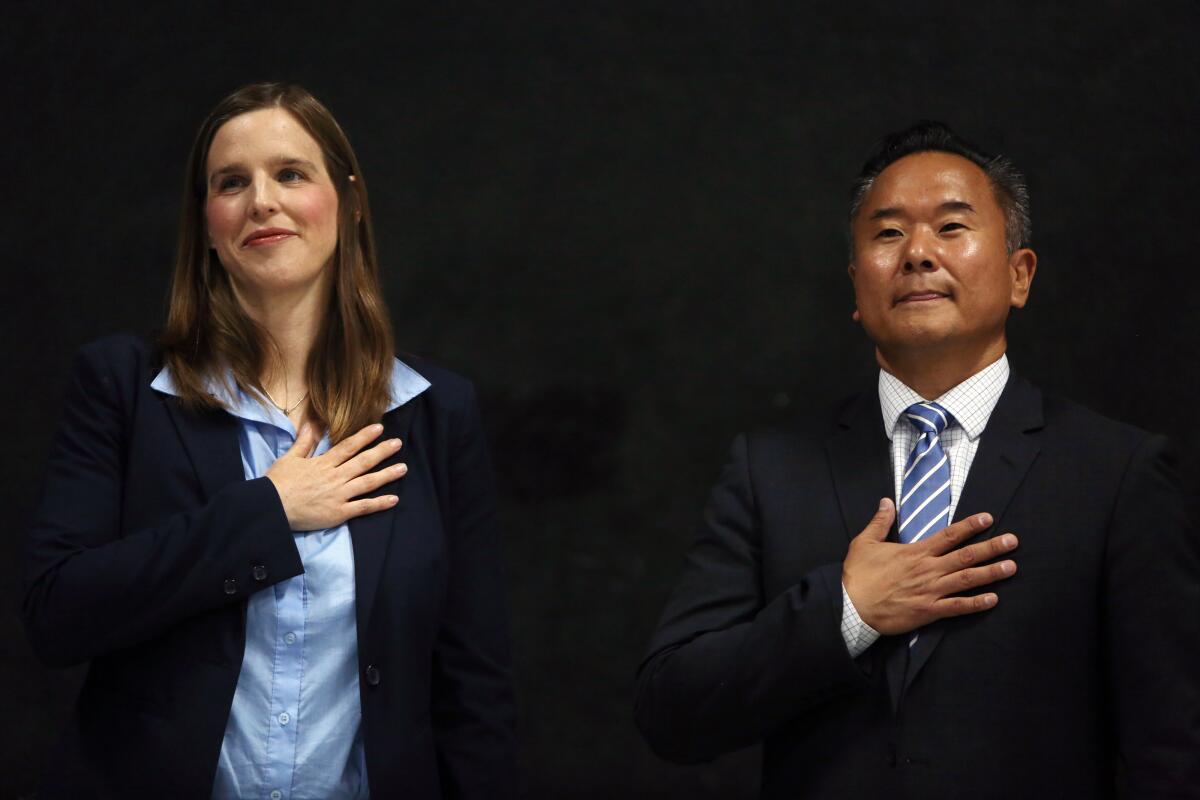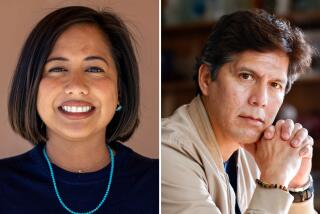Same candidates, new race. Could turnout change the results of this L.A. council rematch?

- Share via
Just months after he was sworn in at City Hall, Los Angeles City Councilman John Lee is facing a rematch for his seat against Loraine Lundquist, the astrophysicist and college educator who lost to Lee in a special election in August.
But key things are different this time around: The presidential primary is expected to drive much bigger turnout in March, likely giving Democrats such as Lundquist a boost at the polls. Despite the northwest San Fernando Valley district’s reputation as a relatively conservative part of L.A., Democrats now outnumber Republicans nearly 2-to-1 among registered voters.
Lee now has the advantage of running as an incumbent. And he has recently shed his Republican registration, campaigning as an unaffiliated candidate in a district where “no party preference” voters make up 27% of registrants.
Lundquist argued that the switch showed “his lack of conviction on anything” and willingness to “say anything that he needs to say in order to get elected.” Lee, who had been registered as a Republican for roughly four years and was “no party preference” before that, said he wanted to show he was an “independent voice.”
“I’m tired of party politics playing such a big influence,” Lee said. “I’m going to do what I feel is best for the city.”
Neither candidate will be identified by political party on the March ballot. Eric Hacopian, a political consultant who is not working with either candidate, said that Lundquist needs to “nationalize the race” as a Democratic cause in order to win. Lee, in turn, benefits from keeping the focus on local, nonpartisan issues, Hacopian said.
“If there were Ds or Rs next to their names, this would be over,” Hacopian said.
Political progressives threw their weight behind Lundquist last year, hoping to flip a council district long represented by Republicans.
Lundquist embraced L.A.’s version of the Green New Deal and made climate change a central part of her campaign, tying the issue to the Aliso Canyon methane disaster. She and her supporters argued that Lee, who followed a long dynasty of council aides taking over the job, represented the “status quo.”
Lee touted his history representing the district as a City Hall aide, emphasizing his familiarity with neighborhood issues, and said he would bring a “different voice” to the council as a fiscal conservative. He and his allies — including the union that represents Department of Water and Power employees — attacked Lundquist as too extreme for the district and said she would drive up taxes and other costs for residents.
The rival candidates also sparred over the homelessness crisis.
Lundquist emphasized the need for more housing for homeless people in the Valley district, decrying its failure to build new units under Proposition HHH, a $1.2-billion bond measure for supportive housing. Lee argued that drug addiction and mental illness needed more attention than they were getting at City Hall, saying that L.A. was not only facing a housing crisis, but also a “drug crisis” and a “mental illness crisis.”
One of the first issues facing Lee after his election was a planned site for HHH housing in Chatsworth — the first proposed in his district. Lee objected to the Topanga Canyon Boulevard site, which is close to an elementary school and backs up to homes.
“It’s not that we don’t support this project. We just don’t support the location,” Lee said.
He ultimately voted with the rest of the council to award funding for the Chatsworth project after a council committee balked at pulling the item from a package of housing proposals, but continued to argue that the project should be built somewhere else.
Lundquist said that she did not think the Chatsworth site was ideal, but “given what we have now, I’m in support of this project because I feel we have to attack this crisis.” She argued that previous leaders — including council members Lee had worked for — should have been more proactive in finding possible sites.
The councilman has touted how he and his staff responded to the Saddleridge fire and trumpeted his continued opposition to a proposed route for bus rapid transit on Nordhoff Street, a hot topic in the last campaign.
He has put forward 21 motions and resolutions since taking office in August, including a resolution seeking to loosen state rules about how cities can regulate sidewalk vending, another resolution backing any efforts to decommission the Aliso Canyon facility, and a motion to reexamine protected bike lanes and other alterations on Reseda Boulevard.
“Businesses have complained that business is down because people can’t turn into their parking lots,” Lee said.
Lee has resisted pressure to be “politically correct” and instead focused on “just doing the right thing,” said Steve Slutzah, a Lee supporter and Sherwood Forest homeowner who said he appreciated the positions that Lee had taken on the Chatsworth project and the Nordhoff transit route. “I really respect him for taking a stand.”
Lundquist said that if she were in office, she would have focused on rolling out L.A.’s new rules on street vending effectively and seeing how they work before pushing to change the state law, as Lee did in his resolution.
She has not ruled out the proposed route on Nordhoff Street, saying that Metro needs to assess all the possible routes and get community input before it makes any decision. And Lundquist argued that safety has improved on Reseda Boulevard with the bike lanes and other aspects of the Great Streets program, something that should be included in any assessment of its value.
“I’m all for revisiting and improving what we’ve put in place,” Lundquist said, “but the motion didn’t have any indication that they were going to be looking at the data in terms of safety.”
West Hills resident Christina Morton complained that on homelessness, transit and other issues, Lee had catered to “only one type of his constituents — older, wealthier homeowners.”
“If you’re a renter or a bus rider or a progressive person, you don’t have a voice in this district politically,” said Morton, a college student who supports Lundquist.
The Lundquist campaign has also made a key change to its team since August: Last month, the candidate said that one of her campaign consultants was no longer working for her after a Democratic Party activist publicly accused him of sexual assault. Her campaign has since brought on veteran consultant Steve Barkan.
Because only two candidates qualified for the ballot, the race is likely to be decided in March, with little chance of a November runoff. Another possible contender, Asaad Alnajjar, did not make the ballot, but said he is continuing to run as a write-in candidate.
More to Read
Sign up for Essential California
The most important California stories and recommendations in your inbox every morning.
You may occasionally receive promotional content from the Los Angeles Times.











